Girl at Reception With Glass of Wine in Her Hand Art Drawings
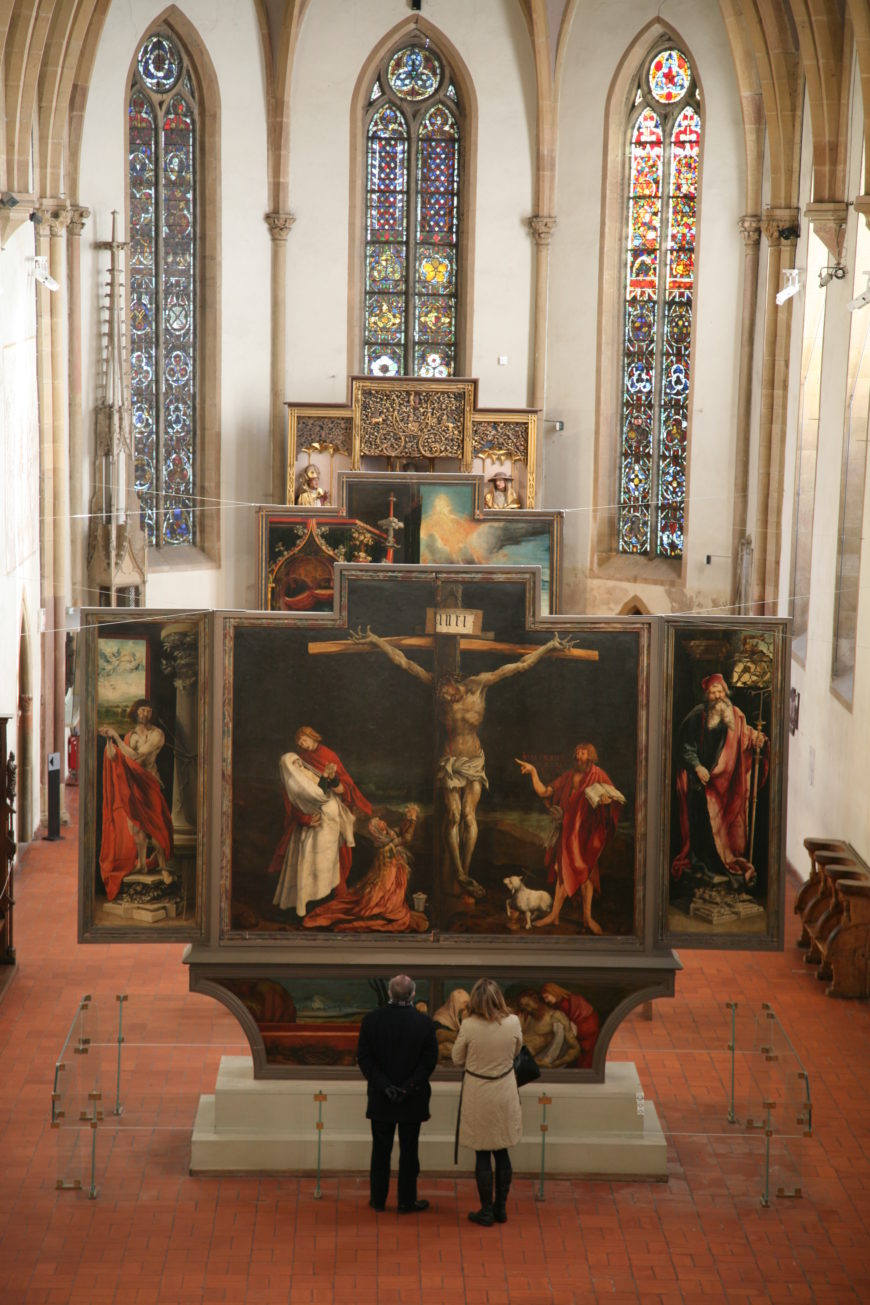
Matthias Grünewald, Isenheim Altarpiece, view in the chapel of the Hospital of Saint Anthony, Isenheim, c. 1510–fifteen, oil on wood, 9′ 9 1/ii″ ten 10′ ix″ (Unterlinden Museum, Colmar, France) (photograph: vincent desjardins, CC BY 2.0)
Object of devotion
If i were to compile a list of the most fantastically weird creative productions of Renaissance Christianity, tiptop honors might well go to Matthias Grünewald'south Isenheim Altarpiece.
Constructed and painted betwixt 1512 and 1516, the enormous moveable altarpiece, essentially a box of statues covered by folding wings, was created to serve as the primal object of devotion in an Isenheim hospital built by the Brothers of St. Anthony. St. Anthony was a patron saint of those suffering from skin diseases. The pig who usually accompanies him in art is a reference to the utilize of pork fat to heal skin infections, only it as well led to Anthony'south adoption equally a patron saint of swineherds, totally unrelated to his reputation for healing and as the patron of basket-weavers, brush-makers, and gravediggers (he start lived as an anchorite, a type of religious hermit, in an empty sepulcher).
At the Isenheim infirmary, the Antonine monks devoted themselves to the intendance of sick and dying peasants, many of them suffering from the effects of ergotism, a illness caused by consuming rye grain infected with fungus. Ergotism, popularly known as St. Anthony's fire, acquired hallucinations and peel infection, and attacked the primal nervous system, eventually leading to death. It is possibly non incidental to Grünewald's vision for his altarpiece that the hallucinogen LSD was eventually isolated from the aforementioned strain of fungus.
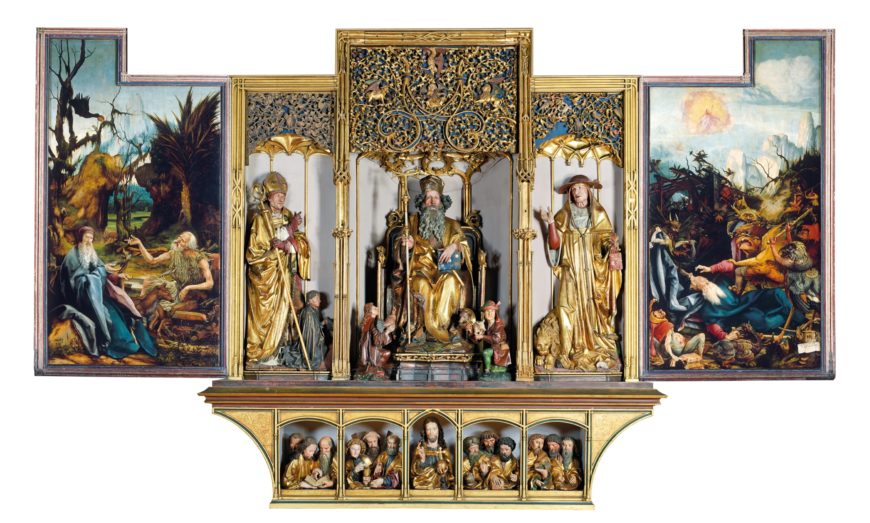
Matthias Grünewald, Isenheim Altarpiece (fully open position, sculptures past Nicolas of Hagenau), 1510–15
Sculpted chantry
Sculpted wooden altars were popular in Germany at the time. At the eye of the altarpiece, Nicolas of Hagenau'southward central carved and gilded ensemble consists of rather staid, solid and unimaginative representations of three saints important to the Antonine order; a disguised and enthroned St. Anthony flanked by standing figures of St. Jerome and St. Augustine. Below, in the carved predella, usually covered past a painted panel, a carved Christ stands at the middle of seated apostles, 6 to each side, grouped in divide groups of 3. Hagenau'south interior ensemble is therefore symmetrical, rational, mathematical and replete with numerical perfections—one, three, four and twelve.
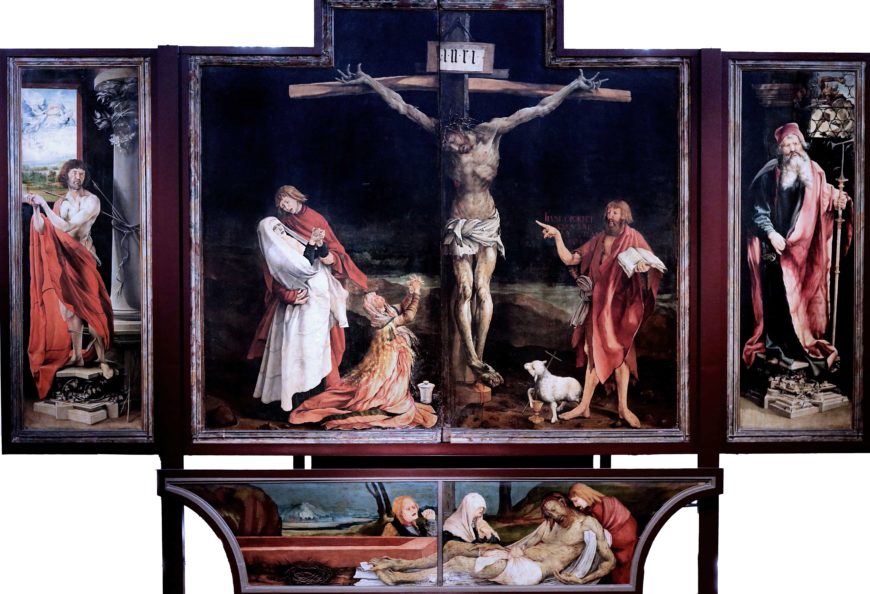
Matthias Grünewald, Isenheim Altarpiece (airtight), 1510–15
Painted panels
Grünewald's painted panels come from a unlike world; visions of hell on earth, in which the concrete and psychological torments that afflicted Christ and a host of saints are rendered as visions wrought in dissonant psychedelic color, and played out by distorted figures—men, women, angels and demons—lit by streaking strident lite and placed in eerie other-worldly landscapes. The painted panels fold out to reveal three singled-out ensembles. In its mutual, closed position the central panels close to draw a horrific, nighttime-time Crucifixion.

Crucifixion (detail), Matthias Grünewald, Isenheim Altarpiece, 1510–15
The macabre and distorted Christ is splayed on the cross, his hands writhing in desperation, his body marked with livid spots of pox. The Virgin swoons into the waiting artillery of the immature St. John the Evangelist while John the Baptist, on the other side (not unremarkably depicted at the Crucifixion), gestures towards the suffering body at the heart and holds a scroll which reads "he must increase, but I must decrease." The emphatic physical suffering was intended to be thaumaturgic (phenomenon performing), a bespeak of identification for the denizens of the hospital. The flanking panels depict St. Sebastian, long known as a plague saint because of his trunk pocked by arrows, and St. Anthony Abbot.
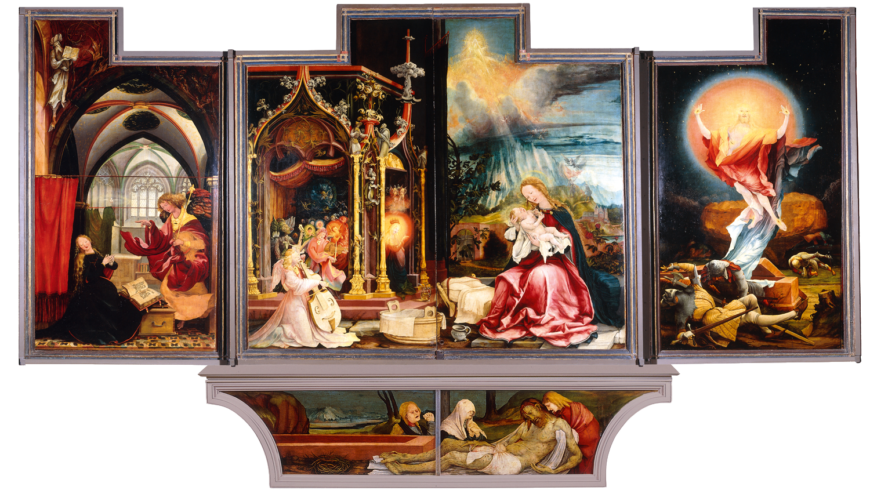
Matthias Grünewald, Isenheim Altarpiece (2d position), 1510–15
The second position emphasizes this promise of resurrection. Its panels describe the Annunciation, the Virgin and Child with a host of musical angels, and the Resurrection. The progression from left to correct is a highlight reel of Christ'south life.
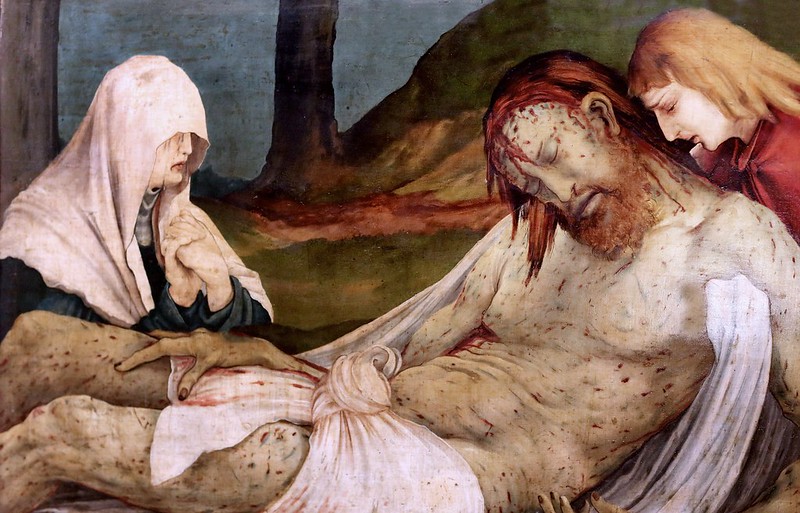
Crucifixion (detail), Matthias Grünewald, Isenheim Altarpiece, 1510–15
In the predella panel is a Lamentation, the sprawling and horrifyingly punctured dead torso of Christ is presented equally an invitation to contemplate mortality and resurrection.

Virgin and child (detail), Matthias Grünewald, Isenheim Altarpiece, 1510–15 (photo: Gzen92, CC BY-SA 4.0)
Idiosyncratic visions
All three scenes are, yet, highly idiosyncratic and personal visions of Biblical exegesis; the musical angels, in their Gothic bandstand, are lit by an eerie orangish-yellow lite while the adjacent Madonna of Humility sits in a twilight mural lit past flickering, fiery atmospheric clouds.
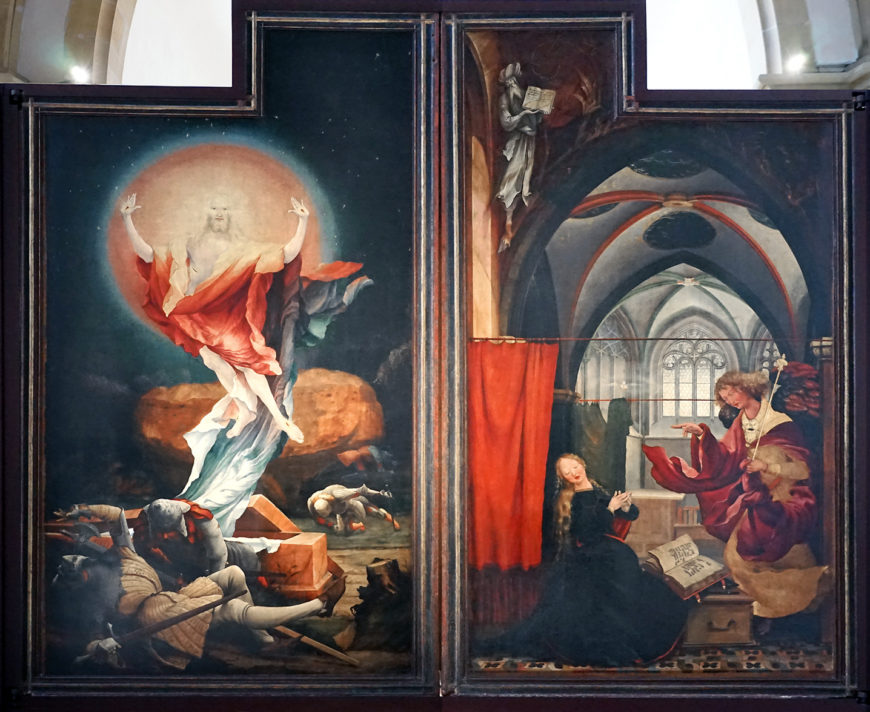
Resurrection and Announcement panels , Matthias Grünewald, Isenheim Altarpiece, 1510–15 (photograph: Edelseider, CC Past 2.0)
The Resurrection panel is the strangest of these inner visions. Christ is wreathed in orangish, ruddy and yellow body halos and rises like a streaking fireball, hovering over the sepulcher and the bodies of the sleeping soldiers, a combination of Transfiguration, Resurrection and Ascent.
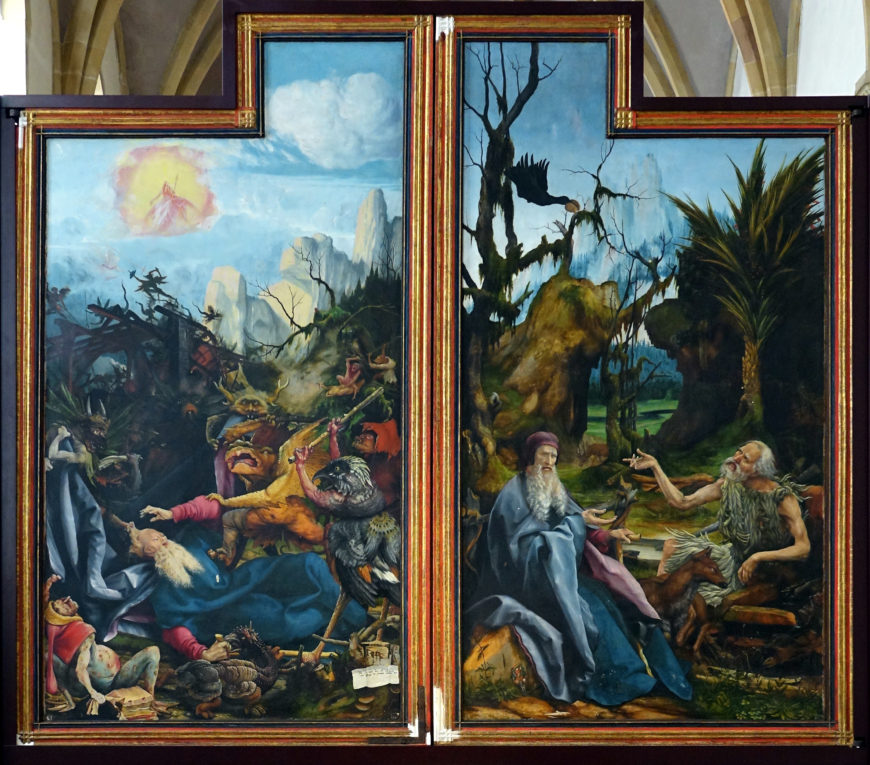
Far left and far right panels seen when altarpiece is fully open up (here illustrated sided-by-side). The Temptations of Saint Anthony (left), Anthony visited past Saint Paul (right), Matthias Grünewald, Isenheim Altarpiece, 1510–15 (photo: Gzen92, CC By-SA iv.0)
Hybrid demons
Grünewald saves his well-nigh esoteric visions for the fully open position of the altar, in the 2 inner panels that flank the key sculptures. On the left, St. Anthony is visited in the blasted-out wilderness by St. Paul (the kickoff hermit of the desert)— the two are about to be fed by the raven in the tree to a higher place, and Anthony will later be chosen upon to bury St. Paul. The coming together cured St. Anthony of the misperception that he was the showtime desert hermit, and was therefore a lesson in humility.
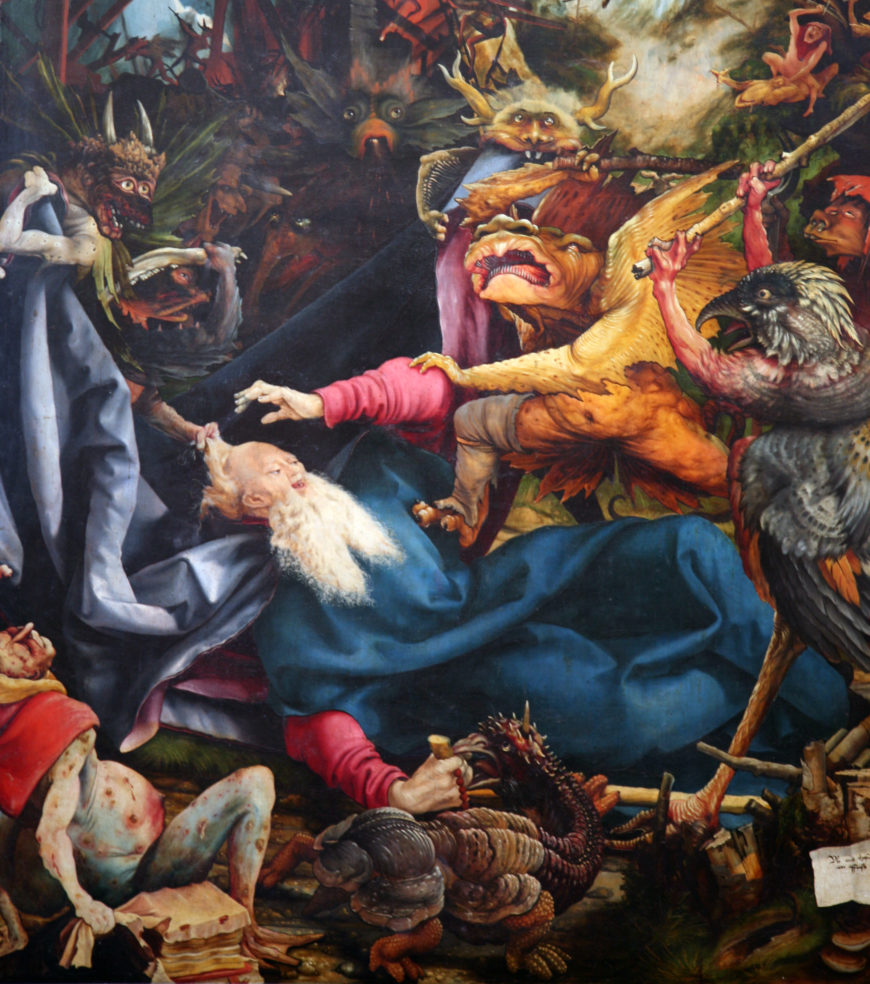
Temptations of Saint Anthony console (detail), Matthias Grünewald, Isenheim Altarpiece, 1510–15 (photo: Edelseider, CC Past 2.0)
In the final panel, Grünewald lets his imagination run anarchism in the depiction of St. Anthony'south temptations in the desert; sublime hybrid demons, like Daliesque dreams, torment Anthony's waking and sleeping hours, bringing to life the saint's torment and mirroring the concrete and psychic suffering of the infirmary patients.
Grünewald's mastery of medieval monstrosity echoes and evokes Hieronymus Bosch and has inspired artists always since. The entire altarpiece is a paean to human suffering and an essay on faith and the promise for sky in the troubled years before the Reformation.
Additional resources:
Ann Stieglitz, "The Reproduction of Agony: Toward a Reception-History of Grünewald's Isenheim Altar after the First World State of war" in Oxford Art Journal vol. 12, no. 2, 1989 (Oxford University Press)
Source: https://smarthistory.org/grunewald-isenheim-altarpiece/
Postar um comentário for "Girl at Reception With Glass of Wine in Her Hand Art Drawings"